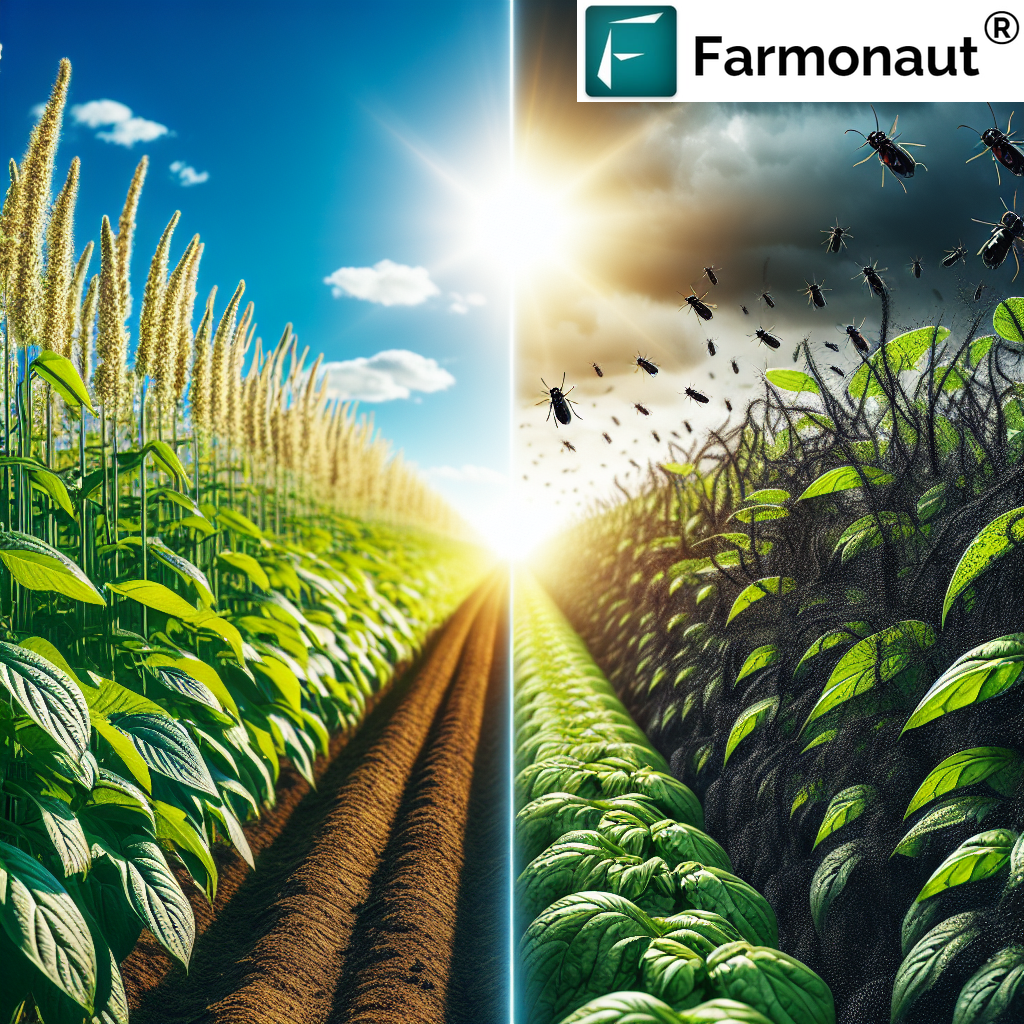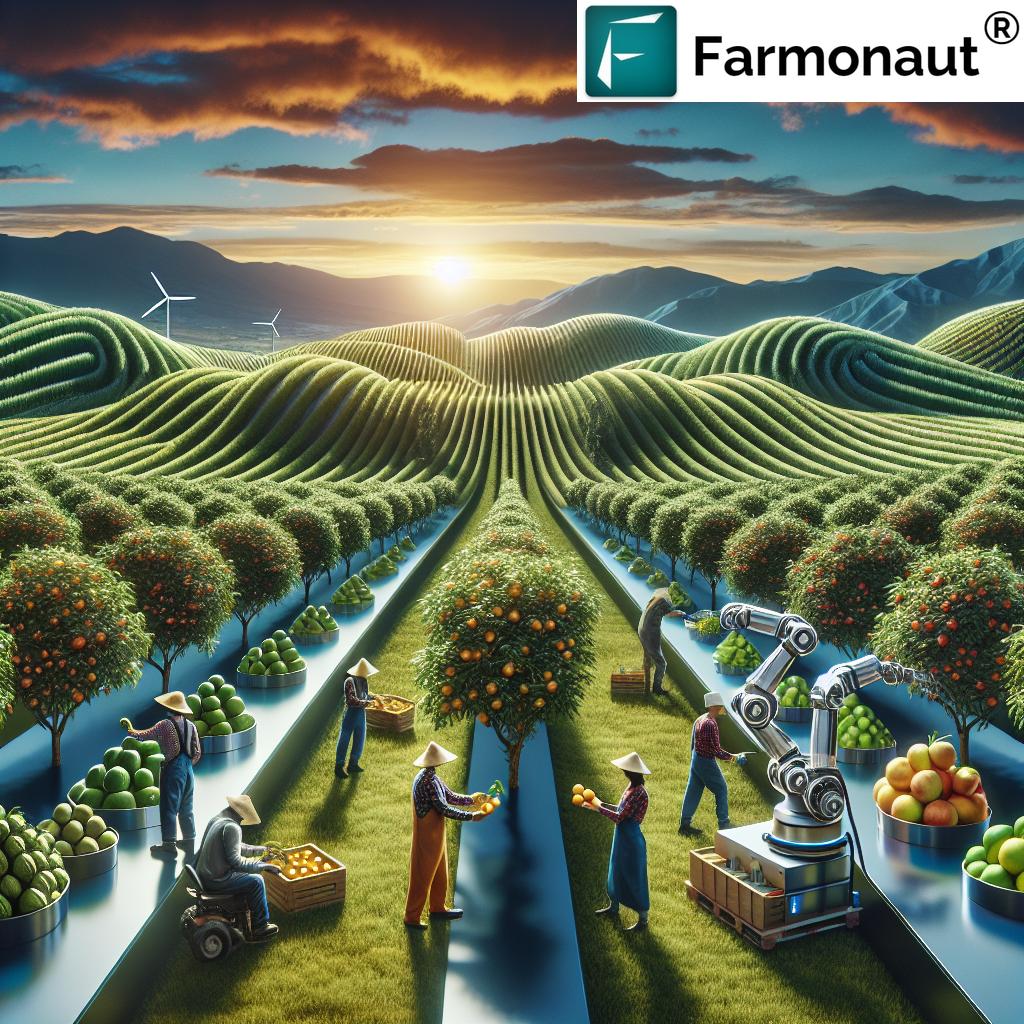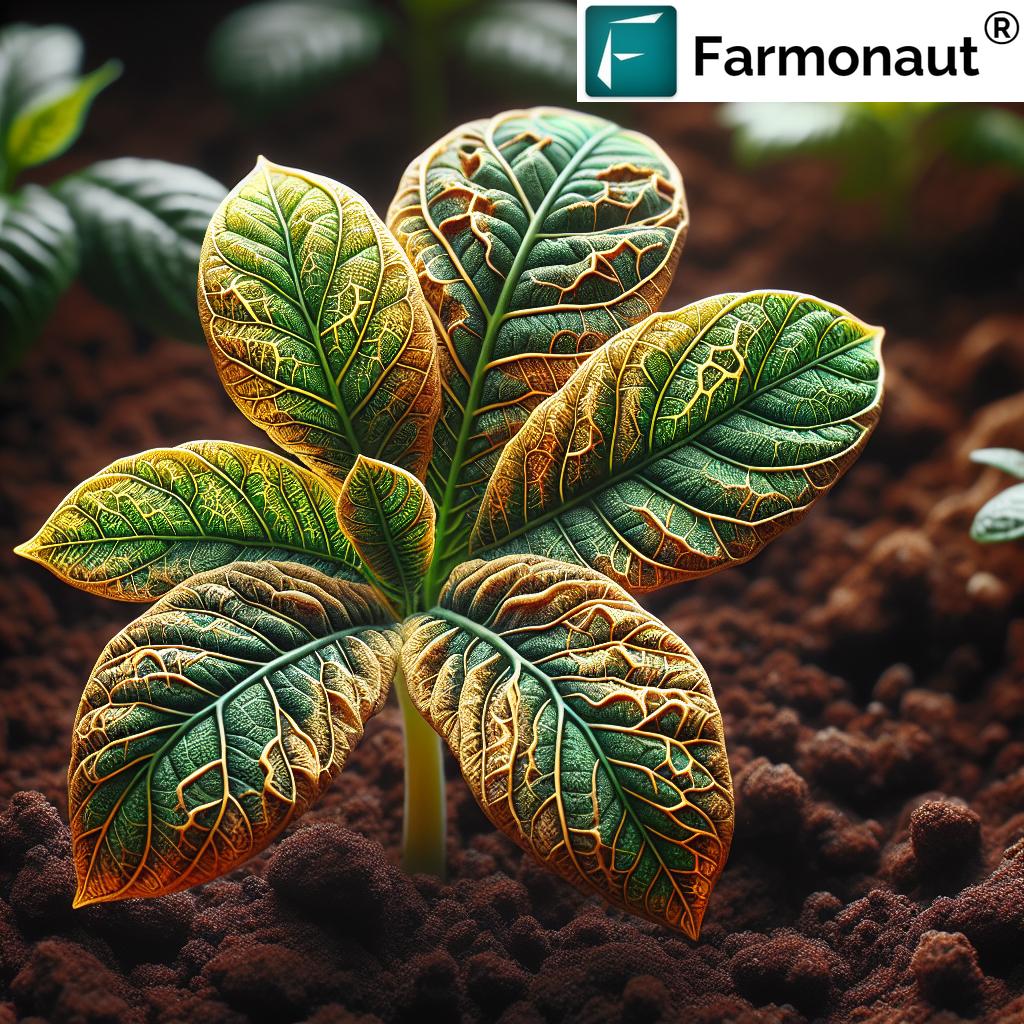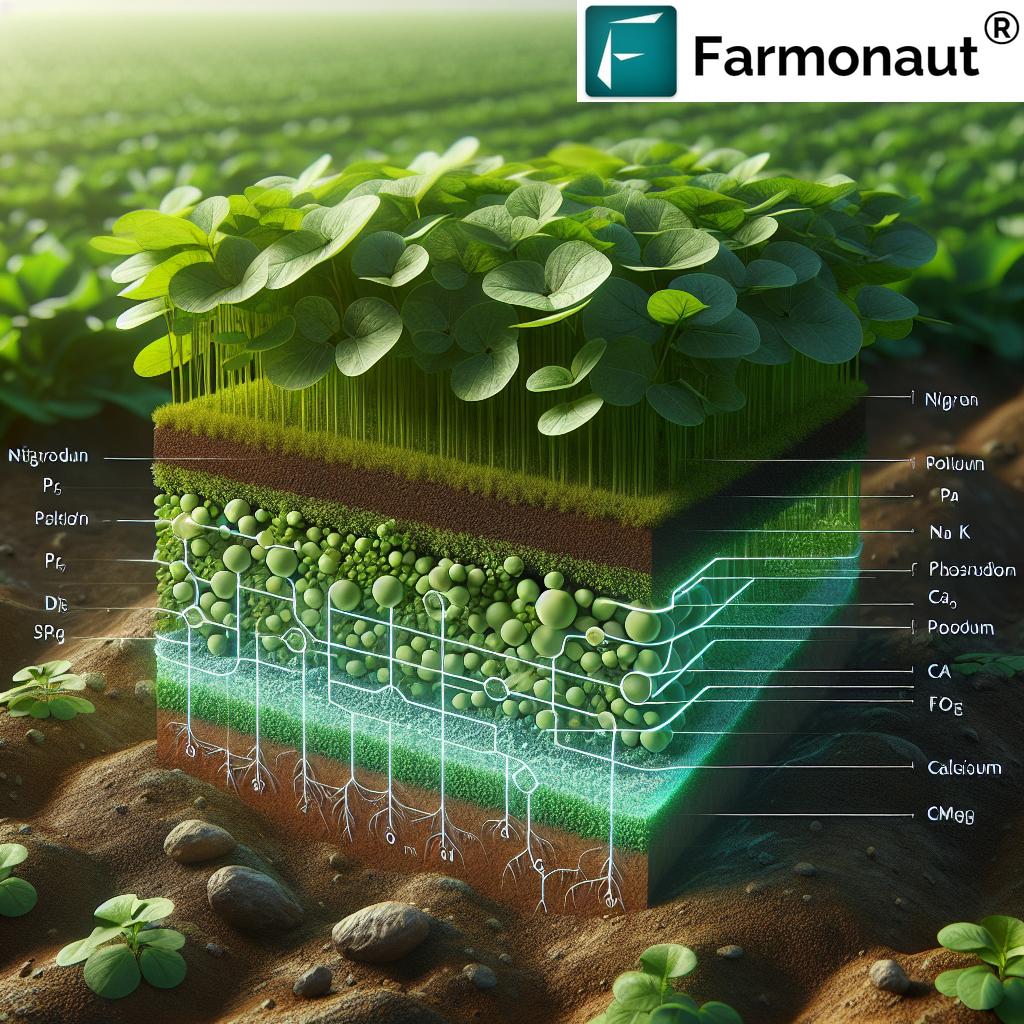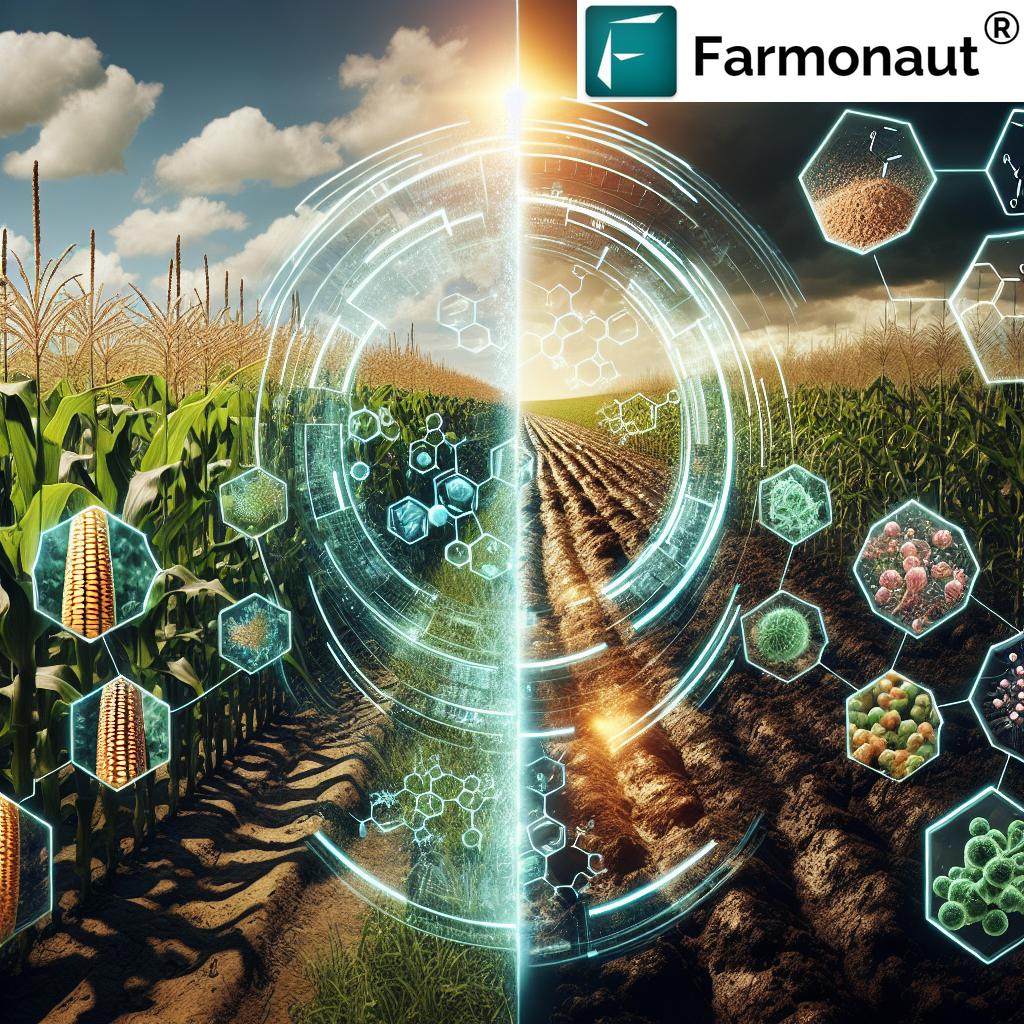The Ultimate Guide to Lacto-Fermentation: Boost Your Gut Health with Homemade Probiotic Pickles
“Lacto-fermentation can transform over 20 different vegetables into probiotic-rich pickles, including cucumbers, carrots, and peppers.”
Welcome to our comprehensive guide on lacto-fermentation, the ancient art of pickling that not only preserves your vegetables but also transforms them into probiotic powerhouses. In this article, we’ll explore the fascinating world of homemade pickles and how they can revolutionize your gut health. Whether you’re a seasoned farmer or a curious gardening enthusiast, this guide will equip you with the knowledge to create delicious, probiotic-rich pickles right in your own kitchen.
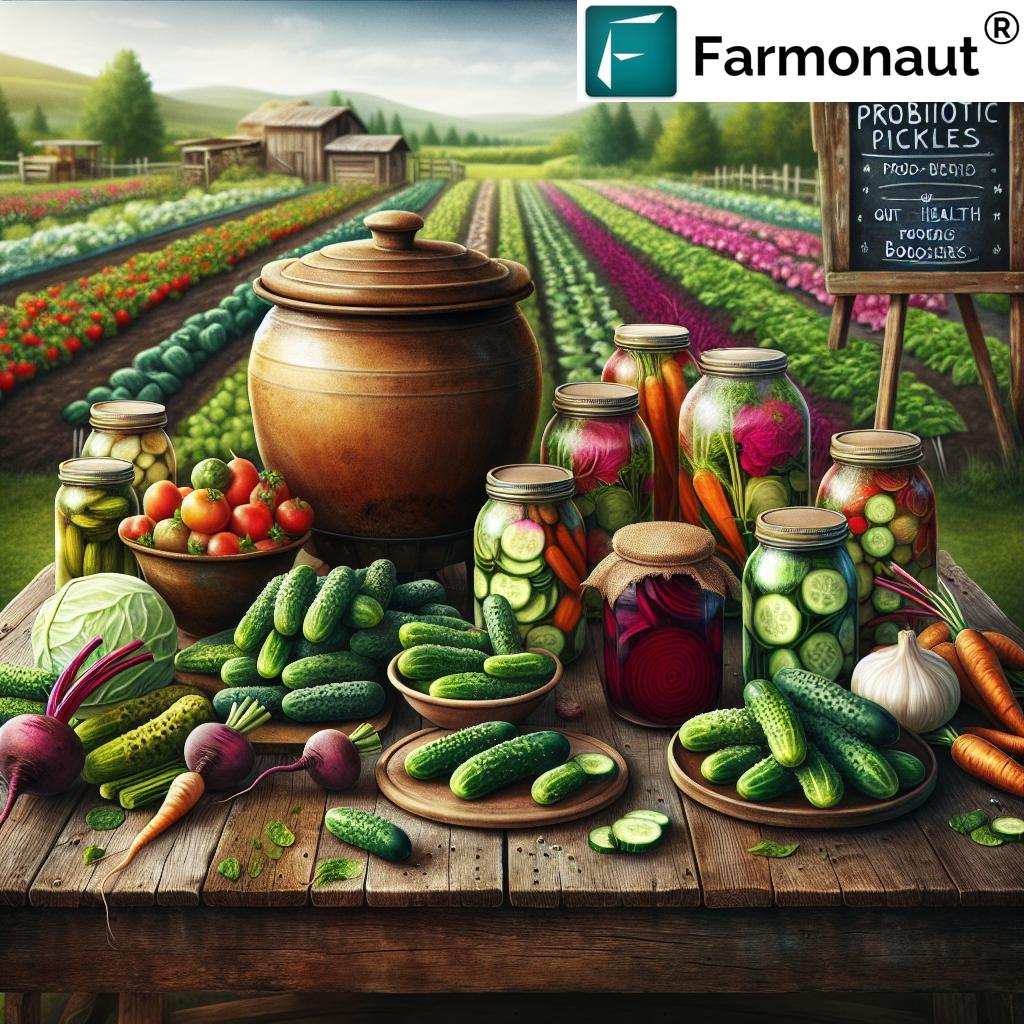
What is Lacto-Fermentation?
Lacto-fermentation is a natural food preservation technique that harnesses the power of beneficial bacteria to transform fresh produce into tangy, flavorful pickles. This process not only extends the shelf life of your vegetables but also enhances their nutritional profile by creating probiotics.
At its core, lacto-fermentation relies on lactic acid bacteria naturally present on the surface of fruits and vegetables. When we create the right environment, these bacteria thrive and convert the sugars and starches in the produce into lactic acid. This acidic environment preserves the vegetables and gives fermented foods their characteristic tangy flavor.
The Benefits of Lacto-Fermented Foods
- Improved Gut Health: Fermented foods are rich in probiotics, which support a healthy gut microbiome.
- Enhanced Nutrient Absorption: The fermentation process can make certain nutrients more bioavailable.
- Boosted Immune System: A healthy gut is closely linked to a strong immune system.
- Natural Preservation: Lacto-fermentation extends the shelf life of produce without artificial preservatives.
- Unique Flavors: The fermentation process creates complex, tangy flavors that many find delicious.
Now that we understand the basics and benefits of lacto-fermentation, let’s dive into the practical aspects of creating your own probiotic pickles at home.
Essential Equipment for Lacto-Fermentation
Before we start our pickling journey, it’s important to gather the right equipment. Here’s what you’ll need:
- Fermentation Vessels: Glass jars or ceramic crocks work best. Avoid metal containers as they can react with the acidic environment.
- Weights: To keep your vegetables submerged in the brine. You can use glass weights or even a clean stone.
- Airlock System: This allows gases to escape without letting air in. You can use specialized fermentation lids or a simple setup with a rubber band and cloth.
- Knife and Cutting Board: For preparing your vegetables.
- Large Bowl: For mixing your brine and vegetables.
- Measuring Spoons and Cups: For accurate brine preparation.
With these tools at hand, you’re ready to start your lacto-fermentation adventure!
Choosing the Best Vegetables for Pickling
While many vegetables can be pickled through lacto-fermentation, some are particularly well-suited to the process. Here’s a quick guide to popular choices:
| Vegetable Name | Fermentation Time (days) | Ideal Brine Concentration (% salt) | Flavor Profile | Probiotic Benefits | Best Serving Suggestions |
|---|---|---|---|---|---|
| Cucumbers | 7-14 | 2-3% | Crisp, tangy | High | As a side dish or in sandwiches |
| Carrots | 10-21 | 2% | Sweet, slightly sour | Medium | In salads or as a snack |
| Peppers | 7-14 | 2-3% | Spicy, tangy | Medium | As a condiment or in tacos |
| Cabbage (Sauerkraut) | 21-28 | 2% | Sour, complex | High | With meats or in Reuben sandwiches |
| Radishes | 7-14 | 2% | Peppery, tangy | Medium | In salads or as a garnish |
Remember, the key to successful pickling is using fresh, high-quality produce. If you’re growing your own vegetables, you’re already off to a great start!
For farmers and gardeners looking to optimize their crop health and yield, consider using Farmonaut’s satellite-based crop monitoring services. Our advanced technology can help you ensure your vegetables are in prime condition for pickling.
The Lacto-Fermentation Process: Step by Step
Now that we’ve covered the basics, let’s walk through the lacto-fermentation process:
- Prepare Your Vegetables: Wash and cut your chosen vegetables into your desired shape and size.
- Create the Brine: Dissolve salt in filtered water to create a 2-3% salt solution. Use non-iodized salt for best results.
- Pack the Vegetables: Tightly pack your prepared vegetables into your fermentation vessel.
- Add Flavorings: This is optional, but you can add herbs and spices like dill, garlic, or peppercorns for extra flavor.
- Pour the Brine: Cover the vegetables completely with your prepared brine.
- Weigh Down: Use weights to keep the vegetables submerged under the brine.
- Seal: Close your container with an airlock system to allow gases to escape while preventing air from entering.
- Ferment: Leave your vegetables to ferment at room temperature, away from direct sunlight.
- Monitor: Check your ferment daily. You may see bubbles forming – this is a good sign!
- Taste and Store: After the recommended fermentation time, taste your pickles. When you’re happy with the flavor, transfer them to the refrigerator to slow down fermentation.
“A properly fermented pickle can contain up to 100 billion colony-forming units (CFUs) of beneficial bacteria per serving.”
Troubleshooting Common Fermentation Issues
Even with the best preparation, you might encounter some challenges during the fermentation process. Here are some common issues and how to address them:
- Mold Growth: If you see white, fuzzy mold on the surface, remove it along with any affected vegetables. If the mold is extensive, it’s best to start over.
- Soft or Mushy Vegetables: This can be caused by too high temperatures or using overripe vegetables. Ensure you’re fermenting at room temperature and using fresh produce.
- Lack of Bubbles: If you don’t see any fermentation activity after a few days, your brine might not have enough salt, or the temperature might be too low.
- Off Odors: A slight sour smell is normal, but any foul or rotten odors indicate that something has gone wrong. In this case, it’s safest to discard the batch and start again.
Remember, practice makes perfect. Don’t be discouraged if your first attempt isn’t perfect – each batch will teach you something new about the art of lacto-fermentation.
Beyond Pickles: Other Lacto-Fermented Foods
While we’ve focused on vegetable pickles in this guide, the world of lacto-fermentation extends far beyond cucumbers and carrots. Here are some other delicious fermented foods you might want to try:
- Sauerkraut: A classic fermented cabbage dish.
- Kimchi: A spicy Korean fermented vegetable mix.
- Kefir: A fermented milk drink.
- Kombucha: A fermented tea beverage.
- Sourdough Bread: Made using a fermented starter.
Each of these foods offers unique flavors and health benefits, showcasing the versatility of lacto-fermentation.

Integrating Fermented Foods into Your Diet
Now that you’ve mastered the art of lacto-fermentation, it’s time to incorporate these probiotic-rich foods into your daily diet. Here are some tips:
- Start Small: Begin with small portions to allow your digestive system to adjust.
- Variety is Key: Try different fermented foods to benefit from a diverse range of probiotics.
- Use as Condiments: Add fermented vegetables to sandwiches, salads, or as side dishes.
- Cook with Care: While cooking can destroy probiotics, fermented foods can still add flavor to cooked dishes.
- Stay Consistent: Regular consumption of fermented foods is key to reaping their health benefits.
For farmers looking to diversify their crops and meet the growing demand for fermentation-friendly produce, Farmonaut’s agricultural technologies can provide valuable insights. Our satellite-based monitoring can help you optimize your farming practices for the best yield and quality.
Explore Farmonaut’s API for advanced agricultural data
The Science Behind Lacto-Fermentation
To truly appreciate the lacto-fermentation process, it’s helpful to understand the science behind it. Here’s a deeper look into what’s happening in your fermentation jars:
- Bacterial Action: The main players in lacto-fermentation are lactic acid bacteria (LAB), primarily from the Lactobacillus genus. These bacteria are naturally present on the surface of fruits and vegetables.
- Anaerobic Environment: By submerging vegetables in brine, we create an oxygen-free environment that favors the growth of LAB while inhibiting harmful bacteria.
- Salt’s Role: Salt not only flavors the pickles but also creates an environment where LAB can thrive while deterring the growth of unwanted microorganisms.
- Acid Production: As LAB consume the sugars in the vegetables, they produce lactic acid. This acidification is what preserves the food and creates the tangy flavor we associate with pickles.
- Probiotic Formation: Throughout the fermentation process, the LAB multiply, creating a rich source of probiotics in the final product.
Understanding these processes can help you troubleshoot any issues and appreciate the complexity of your homemade ferments.
Lacto-Fermentation vs. Other Preservation Methods
While lacto-fermentation is an excellent way to preserve vegetables, it’s not the only method available. Let’s compare it to other common preservation techniques:
- Canning: Uses heat to kill microorganisms and create a vacuum seal. While effective, this process can destroy some nutrients and doesn’t create probiotics.
- Freezing: Preserves foods by slowing down decomposition. It maintains nutrients but doesn’t enhance them or create probiotics.
- Dehydration: Removes moisture to prevent bacterial growth. It concentrates nutrients but doesn’t create the beneficial bacteria found in fermented foods.
- Vinegar Pickling: Uses acetic acid to preserve foods. While it creates a similar tangy flavor, it doesn’t offer the probiotic benefits of lacto-fermentation.
Each method has its place, but lacto-fermentation stands out for its ability to not only preserve food but also enhance its nutritional profile.
For farmers interested in diversifying their product offerings, consider using Farmonaut’s technology to optimize your crop production for various preservation methods, including lacto-fermentation.
Seasonal Fermentation: Preserving the Harvest
One of the great advantages of lacto-fermentation is its ability to preserve seasonal abundance. Here’s how you can make the most of your garden or local farmer’s market throughout the year:
- Spring: Ferment asparagus, radishes, and spring onions.
- Summer: Take advantage of the cucumber and pepper harvest for classic pickles.
- Fall: Preserve the last of the summer vegetables and start fermenting hardy fall produce like cabbage for sauerkraut.
- Winter: Experiment with fermenting root vegetables like carrots and beets.
By following the seasons, you can ensure a constant supply of varied, probiotic-rich foods throughout the year.
Safety Considerations in Lacto-Fermentation
While lacto-fermentation is generally a safe process, it’s important to follow good hygiene practices to ensure your ferments are not only delicious but also safe to consume. Here are some key safety tips:
- Use clean equipment and work surfaces to prevent contamination.
- Ensure your vegetables are fully submerged in the brine throughout the fermentation process.
- If you see any signs of mold or detect off odors, err on the side of caution and discard the batch.
- Store your fermented foods in the refrigerator once they’ve reached your desired flavor profile.
- Trust your senses – if something doesn’t look, smell, or taste right, don’t consume it.
By following these guidelines, you can enjoy your homemade ferments with confidence.
For farmers and food producers, ensuring food safety is paramount. Farmonaut’s technology can help you monitor and optimize growing conditions, contributing to the production of safe, high-quality produce suitable for fermentation.
The Future of Fermentation
As we look to the future, the popularity of fermented foods shows no signs of slowing down. Here are some trends we’re seeing in the world of fermentation:
- Innovative Flavors: Chefs and home fermenters are experimenting with unique ingredient combinations and global flavors.
- Functional Foods: There’s growing interest in fermented foods that offer specific health benefits beyond general gut health.
- Sustainable Practices: Fermentation is being recognized as a sustainable food preservation method that can help reduce food waste.
- Artisanal Products: Small-batch, artisanal fermented products are gaining popularity in specialty food markets.
As these trends evolve, the ancient art of lacto-fermentation continues to find new relevance in our modern world.
Conclusion: Embracing the Fermentation Lifestyle
Lacto-fermentation is more than just a food preservation technique – it’s a gateway to better health, exciting flavors, and a deeper connection with our food. By creating your own probiotic-rich pickles and other fermented foods, you’re not only nourishing your body but also participating in a timeless culinary tradition.
We hope this guide has inspired you to start your own fermentation journey. Remember, every batch is an opportunity to learn and refine your skills. Don’t be afraid to experiment with different vegetables, spices, and techniques. The world of lacto-fermentation is vast and full of delicious possibilities.
Whether you’re a farmer looking to diversify your crop uses, a gardener with an abundance of homegrown vegetables, or simply someone interested in improving their gut health, lacto-fermentation has something to offer you. So grab those jars, prepare your brine, and get ready to transform your vegetables into probiotic powerhouses. Your gut (and your taste buds) will thank you!
For farmers and agricultural professionals interested in optimizing their crop production for fermentation and other uses, explore Farmonaut’s comprehensive suite of agricultural technology solutions. Our satellite-based monitoring and AI-driven insights can help you take your farming practices to the next level.
Check out Farmonaut’s API Developer Docs for advanced agricultural data integration
Frequently Asked Questions
Q: What’s the difference between lacto-fermentation and regular pickling?
A: Lacto-fermentation relies on beneficial bacteria to preserve and flavor foods, creating probiotics in the process. Regular pickling typically uses vinegar to preserve foods, which doesn’t create probiotics.
Q: How long do lacto-fermented foods last?
A: When stored in the refrigerator, lacto-fermented foods can last for several months to a year. However, their flavor and texture may continue to change over time.
Q: Can I use tap water for my brine?
A: It’s best to use filtered or spring water for your brine. Chlorine in tap water can inhibit the growth of beneficial bacteria.
Q: Is it normal for my ferment to bubble and fizz?
A: Yes, bubbling is a normal and good sign! It indicates that fermentation is actively occurring.
Q: Can I ferment fruits using this method?
A: While this guide focuses on vegetables, many fruits can also be fermented using similar methods. However, their higher sugar content may require some adjustments to the process.
We hope this guide has answered your questions and inspired you to start your lacto-fermentation journey. Remember, practice makes perfect, and each batch is an opportunity to learn and refine your skills. Happy fermenting!









